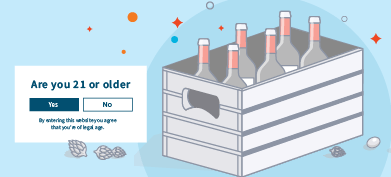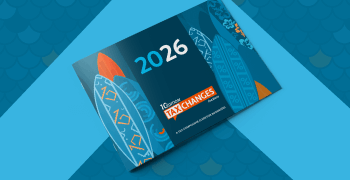
Best practices for weaving compliance into your DTC workflow
Because of the nature of alcohol, companies that sell beverage alcohol directly to consumers are generally subject to more regulations than sellers of, say, socks. And because of the character of the regulations, mistakes can be costly. Developing a process that includes age verification, tax calculation, and a baked-in compliance workflow helps ensure essential requirements are met.
Verify age
Although online beverage alcohol sellers can’t inspect a buyer’s physical photo ID as easily as brick-and-mortar sellers, they can and should confirm consumers are old enough to purchase or receive alcohol.
There are four age-verification best practices:
- Build an age gate
- Collect date of birth
- Verify age of purchaser
- Check recipient’s ID at point of delivery
Build an age gate
Just as businesses often “gate” online content by requiring visitors to provide their name and contact information, direct-to-consumer (DTC) beverage alcohol sellers can restrict access to online alcohol sales by making visitors affirm they’re old enough to purchase alcohol — either by asking the visitor to confirm they’re of legal age (21) or requiring them to enter their birth date. Underage visitors aren’t permitted to enter the site.
Collect date of birth
Ecommerce alcohol sellers can make shoppers jump through the above legal hoop every time they visit the webstore. Alternatively, a seller can collect and securely store birthdates so repeat shoppers with a verified account can skip that step — a good time to collect this information is when a purchaser signs up for a membership with a wine club. This is a relatively common practice because some states require sellers to report each purchaser’s date of birth.
When a buyer purchases alcohol to ship to someone else, sellers must have a system to collect and securely store the birthdate of the recipient. As above, some states require sellers to report this information.
Verify age of purchaser
Since collecting a date of birth doesn’t ensure legitimacy, many states mandate sellers take additional steps to verify the age of each purchaser and/or recipient. There are two ways to do this: Collect and store a valid identifying document (e.g., a government-issued ID), or use a state-approved online verification provider.
With the first option, the seller must collect and store the ID in a secure manner and ensure it’s up to date — expired licenses aren’t valid.
Online verification providers vet IDs through publicly available data. Using them can relieve the seller of liability and add an extra layer of security, though for a fee. Not all states accept all verification service providers, so if you’re interested in going this route, check with your state alcohol beverage control board or department of licensing.
Check recipient’s ID at point of delivery
States that permit DTC alcohol shipments don’t want them delivered to minors or left at the door where minors can get hold of them. Thus, packages containing alcohol must be clearly labeled as such, and common carriers must check government-issued identification and obtain an adult signature at the point of delivery.
It’s in the best interest of a DTC alcohol seller to properly label packages and have an agreement with the carrier to deliver alcohol. So long as these steps have been taken, the carrier would be liable for this step should alcohol be delivered into the hands of a minor or left unattended at the door.
Calculate, collect, and remit applicable taxes
Beverage alcohol transactions are generally subject to excise tax and/or sales tax, and sometimes additional taxes as well. Different states have different tax collection and reporting requirements.
For example, Texas requires direct shippers to remit both excise and sales tax, while famously opposed to sales tax New Hampshire imposes a “mark-up fee.” In Kentucky, direct shippers must register to collect excise tax, the state sales tax, and a “wholesale sales tax.” These taxes are based on the consumer’s shipping address and must be “collected by the direct shipper licensee from the consumer” and “separately identified on the consumer’s invoice.” Sales and excise tax must be reported every month, but direct shipment reports are due quarterly.
Making matters more complex, tax obligations are subject to change. For example, out-of-state wineries and retailers aren’t required to register or collect sales tax prior to July 1, 2021, when Florida starts enforcing economic nexus; they’re liable for monthly excise tax only. However, on and after July 1, out-of-state wine producers and retailers with more than $100,000 in sales to Florida consumers during the previous calendar year must register then collect and remit applicable Florida sales tax.
Streamlining tax calculation, collection, and remittance helps reduce the burden of compliance.
Bake in a compliance workflow
Online orders may not be quite as quick as grabbing a bottle off the shelf of the corner store, but with a streamlined shipping process, they can happen remarkably fast. Today, it’s common for shipments to go out the same day, often in a matter of hours: Clicking Buy now or Complete transaction moves an order right into the fulfillment queue. Because of this, building a quarantine process into the workflow is essential.
What is a quarantine?
Most of us are all-too familiar with quarantining thanks to COVID-19. With alcohol ecommerce, it’s much like what we’ve experienced in our own lives: a period of isolation.
Beverage alcohol orders need to be quarantined whenever a transaction isn’t compliant for one reason or another. Examples of noncompliant transactions include when a purchaser provides an address destined for a dry city or county, or when an order would be over a state’s volume limit. For example, Texas permits wineries to ship up to nine gallons per person per month, so an order that would put a Texas consumer at 10 gallons for the month would be noncompliant.
Without an automated process to identify and pull noncompliant orders, they’d likely be delivered, and sellers would have to deal with any negative consequences. Avalara Shipping Verification helps ensure noncompliant orders don’t ship as is by running a series of checks on each Avalara AvaTax transaction and identifying each as compliant or noncompliant. Noncompliant orders are then quarantined so they don’t get swept up in the shipping cycle.
Quarantining an order doesn’t automatically cancel it — it merely gives the seller and customer time to come up with a solution. In the above Texas example, the seller could hold a portion of an order back to the next month if they haven’t yet maximized their annual limit.
Grow your online alcohol sales with confidence
The pandemic marked a huge inflection point for DTC beverage alcohol sellers, leading to a value growth of over 80% in 2019–2020. Furthermore, U.S. total alcohol ecommerce revenue is expected to grow six-fold between 2019 and 2024. Such a rapid rise in sales will likely lead to more regulation and tougher enforcement efforts by states.
Automating tax collection and remittance and streamlining the shipping process can help DTC beverage alcohol sellers minimize growing pains and improve compliance. To learn more about AvaTax for Beverage Alcohol or Avalara Shipping Verification, contact us to set up a live demo.
The 4 steps to age verification for direct shippers
Make sure you’re following the rules when it comes to selling to customers 21 and over.


Avalara Tax Changes 2026 is here
The 10th edition of our annual report engagingly breaks down key policies related to sales tax, tariffs, and VAT.
Stay up to date
Sign up for our free newsletter and stay up to date with the latest tax news.














